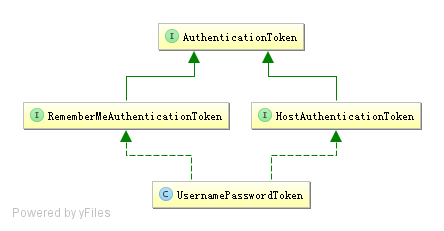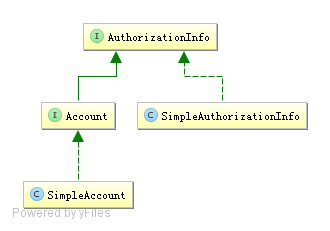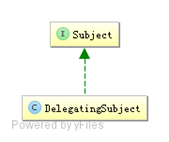Realm 定义实体及关系
用户-角色 之间是多对多关系,角色-权限 之间是多对多关系;且用户和权限之间通过角色建立关系。权限验证,角色只是权限集合,即所谓的显式角色。
用户 实体包括:编号id、用户名username、密码password、盐salt、是否锁定locked;角色 实体包括:、编号id、角色标识符role、描述description、是否可用available;权限 实体包括:编号id、权限标识符permission、描述description、是否可用available。
另外还有两个关系实体 :用户-角色 实体:用户编号、角色编号,且组合为复合主键);角色-权限 实体:角色编号、权限编号,且组合为复合主键)。
环境准备 为了方便数据库操作,使用 org.springframework: spring-jdbc: 4.0.0.RELEASE 依赖。
定义Service及Dao
为了实现的简单性,只实现必须的功能,其他的可以自己实现即可。
PermissionService 实现基本的创建/删除 权限。
public interface PermissionService { public Permission createPermission(Permission permission); public void deletePermission(Long permissionId); }
RoleService 相对于PermissionService多了关联/移除关联角色-权限 功能。
public interface RoleService { public Role createRole(Role role); public void deleteRole(Long roleId); // 添加角色-权限之间关系 public void correlationPermissions(Long roleId, Long... permissionIds); // 移除角色-权限之间关系 public void uncorrelationPermissions(Long roleId, Long... permissionIds); }
UserService 使用 findByUsername 、 findRoles 及 findPermissions 来查找用户名对应的帐号、角色及权限信息。
之后的Realm就使用这些方法来查找相关信息。
public interface UserService { // 创建账户 public User createUser(User user); // 修改密码 public void changePassword(Long userId, String newPassword); // 添加用户-角色关系 public void correlationRoles(Long userId, Long... roleIds); // 移除用户-角色关系 public void uncorrelationRoles(Long userId, Long... roleIds); // 根据用户名查找用户 public User findByUsername(String username); // 根据用户名查找其角色 public Set<String> findRoles(String username); // 根据用户名查找其权限 public Set<String> findPermissions(String username); }
UserServiceImpl 在创建账户及修改密码时直接把生成密码操作 委托给 PasswordHelper。
public User createUser(User user) { // 加密密码 passwordUtils.encryptPassword(user); return userDao.createUser(user); } public void changePassword(Long userId, String newPassword) { User user =userDao.findOne(userId); user.setPassword(newPassword); passwordUtils.encryptPassword(user); userDao.updateUser(user); }
PasswordUtils 之后的CredentialsMatcher需要和此处加密的算法一样。
public class PasswordUtils { private RandomNumberGenerator randomNumberGenerator = new SecureRandomNumberGenerator(); private String algorithmName = "md5"; private final int hashIterations = 2; public void encryptPassword(User user) { user.setSalt(randomNumberGenerator.nextBytes().toHex()); String newPassword = new SimpleHash( algorithmName, user.getPassword(), ByteSource.Util.bytes(user.getCredentialsSalt()), hashIterations).toHex(); user.setPassword(newPassword); } }
为了节省篇幅,对于DAO/Service 的接口及实现,具体请参考源码 com.github.gojay001 ;com.github.gojay001.service.ServiceTest 。
定义Realm RetryLimitHashedCredentialsMatcher
com.github.gojay001.credentials
public class RetryLimitHashedCredentialsMatcher extends HashedCredentialsMatcher { private Ehcache passwordRetryCache; public RetryLimitHashedCredentialsMatcher() { CacheManager cacheManager = CacheManager.newInstance(CacheManager.class.getClassLoader().getResource("ehcache.xml")); passwordRetryCache = cacheManager.getCache("passwordRetryCache"); } @Override public boolean doCredentialsMatch(AuthenticationToken token, AuthenticationInfo info) { String username = (String)token.getPrincipal(); // retry count + 1 Element element = passwordRetryCache.get(username); if(element == null) { element = new Element(username , new AtomicInteger(0)); passwordRetryCache.put(element); } AtomicInteger retryCount = (AtomicInteger)element.getObjectValue(); if(retryCount.incrementAndGet() > 5) { // if retry count > 5 throw throw new ExcessiveAttemptsException(); } boolean matches = super.doCredentialsMatch(token, info); if(matches) { // clear retry count passwordRetryCache.remove(username); } return matches; } }
UserRealm
com.github.gojay001.realm
public class UserRealm extends AuthorizingRealm { private UserService userService = new UserServiceImpl(); @Override protected AuthorizationInfo doGetAuthorizationInfo(PrincipalCollection principals) { String username = (String)principals.getPrimaryPrincipal(); SimpleAuthorizationInfo authorizationInfo = new SimpleAuthorizationInfo(); authorizationInfo.setRoles(userService.findRoles(username)); authorizationInfo.setStringPermissions(userService.findPermissions(username)); return authorizationInfo; } @Override protected AuthenticationInfo doGetAuthenticationInfo(AuthenticationToken token) throws AuthenticationException { String username = (String)token.getPrincipal(); User user = userService.findByUsername(username); //没找到帐号 if(user == null) { throw new UnknownAccountException(); } //帐号锁定 if(Boolean.TRUE.equals(user.getLocked())) { throw new LockedAccountException(); } // 交给AuthenticatingRealm使用CredentialsMatcher进行密码匹配,如果觉得人家的不好可以自定义实现 return new SimpleAuthenticationInfo( user.getUsername(), user.getPassword(), // salt=username+salt ByteSource.Util.bytes(user.getCredentialsSalt()), //realm name getName() ); } }
UserRealm父类AuthorizingRealm将获取Subject相关信息分成两步 :获取身份验证信息 doGetAuthenticationInfo 及授权信息 doGetAuthorizationInfo ;doGetAuthenticationInfo :首先根据传入的用户名获取User信息;在组装SimpleAuthenticationInfo信息时,需要传入:身份信息用户名、凭据密文密码、盐username+salt, CredentialsMatcher 使用盐加密传入的明文密码和此处的密文密码进行匹配。doGetAuthorizationInfo :PrincipalCollection 是一个身份集合,因为我们现在就一个Realm,所以直接调用getPrimaryPrincipal得到之前传入的用户名即可;然后根据用户名调用UserService接口获取角色及权限信息。
AuthenticationToken
AuthenticationToken 用于收集用户提交的身份 用户名 及凭据 密码 :
public interface AuthenticationToken extends Serializable { Object getPrincipal(); Object getCredentials(); }
RememberMeAuthenticationToken :提供了 boolean isRememberMe() 记住我 的功能;HostAuthenticationToken :提供了 String getHost() 方法用于获取用户主机 的功能。
Shiro提供了一个直接拿来用的UsernamePasswordToken ,用于实现用户名/密码Token组。实现了 RememberMeAuthenticationToken 和 HostAuthenticationToken ,可以实现记住我及主机验证的支持。
AuthenticationInfo
AuthenticationInfo 有两个作用:
如果Realm是 AuthenticatingRealm 子类,则提供给 AuthenticatingRealm 内部使用的 CredentialsMatcher 进行凭据验证;(如果没有继承它需要在自己的Realm中自己实现验证)。
提供给 SecurityManager 来创建 Subject (提供身份信息)。
MergableAuthenticationInfo 用于提供在多Realm时合并AuthenticationInfo的功能,主要合并Principal。HashedCredentialsMatcher ,在验证时会判断 AuthenticationInfo 是否是SaltedAuthenticationInfo 子类,来获取盐信息。Account 相当于我们之前的 User , SimpleAccount 是其一个实现。SimpleAuthenticationInfo 即可。
PrincipalCollection
因为我们可以在Shiro中同时配置多个Realm,所以身份信息可能就有多个;因此其提供了PrincipalCollection 用于聚合这些身份信息:
public interface PrincipalCollection extends Iterable, Serializable { // 得到主要的身份 Object getPrimaryPrincipal(); // 根据身份类型获取第一个 <T> T oneByType(Class<T> type); // 根据身份类型获取一组 <T> Collection<T> byType(Class<T> type); // 转换为List List asList(); // 转换为Set Set asSet(); // 根据Realm名字获取 Collection fromRealm(String realmName); // 获取所有身份验证通过的Realm名字 Set<String> getRealmNames(); // 判断是否为空 boolean isEmpty(); }
getPrimaryPrincipal :如果只有一个Principal那么直接返回即可,如果有多个Principal,则返回第一个(因为内部使用Map存储,所以可以认为是返回任意一个);oneByType/byType :根据凭据的类型返回相应的Principal;fromRealm 根据Realm名字(每个Principal都与一个Realm关联)获取相应的Principal。
MutablePrincipalCollection 是一个可变的PrincipalCollection接口,即提供了如下可变方法:
public interface MutablePrincipalCollection extends PrincipalCollection { // 添加Realm-Principal的关联 void add(Object principal, String realmName); // 添加一组Realm-Principal的关联 void addAll(Collection principals, String realmName); // 添加PrincipalCollection void addAll(PrincipalCollection principals); // 清空 void clear(); }
AuthorizationInfo
AuthorizationInfo 用于聚合授权信息的:
public interface AuthorizationInfo extends Serializable { // 获取角色字符串信息 Collection<String> getRoles(); // 获取权限字符串信息 Collection<String> getStringPermissions(); // 获取Permission对象信息 Collection<Permission> getObjectPermissions(); }
当我们使用 AuthorizingRealm 时,如果身份验证成功,在进行授权时就通过 doGetAuthorizationInfo 方法获取角色/权限信息用于授权验证。
Shiro提供了一个实现 SimpleAuthorizationInfo ,大多数时候使用这个即可。
Subject
Subject 是Shiro的核心对象,基本所有身份验证、授权都是通过Subject完成。
身份信息获取 // Primary Principal Object getPrincipal(); // PrincipalCollection PrincipalCollection getPrincipals();
身份验证 void login(AuthenticationToken token) throws AuthenticationException; boolean isAuthenticated(); boolean isRemembered();
角色授权验证 boolean hasRole(String roleIdentifier); boolean[] hasRoles(List<String> roleIdentifiers); boolean hasAllRoles(Collection<String> roleIdentifiers); void checkRole(String roleIdentifier) throws AuthorizationException; void checkRoles(Collection<String> roleIdentifiers) throws AuthorizationException; void checkRoles(String... roleIdentifiers) throws AuthorizationException;
权限授权验证 boolean isPermitted(String permission); boolean isPermitted(Permission permission); boolean[] isPermitted(String... permissions); boolean[] isPermitted(List<Permission> permissions); boolean isPermittedAll(String... permissions); boolean isPermittedAll(Collection<Permission> permissions); void checkPermission(String permission) throws AuthorizationException; void checkPermission(Permission permission) throws AuthorizationException; void checkPermissions(String... permissions) throws AuthorizationException; void checkPermissions(Collection<Permission> permissions) throws AuthorizationException;
会话 // 相当于getSession(true) Session getSession(); Session getSession(boolean create);
如果 create=false 如果没有会话将返回null;而 create=true 如果没有会话会强制创建一个。
退出 RunAs void runAs(PrincipalCollection principals) throws NullPointerException, IllegalStateException; boolean isRunAs(); PrincipalCollection getPreviousPrincipals(); PrincipalCollection releaseRunAs();
RunAs 即实现允许A假设为B身份进行访问 :
通过调用 subject.runAs(b) 进行访问;subject.getPrincipals 将获取到B的身份;isRunAs 将返回true,而a的身份需要通过 subject.getPreviousPrincipals 获取;subject.releaseRunAs 即可。
多线程 <V> V execute(Callable<V> callable) throws ExecutionException; void execute(Runnable runnable); <V> Callable<V> associateWith(Callable<V> callable); Runnable associateWith(Runnable runnable);
在多线程执行中需要传播到相应的线程才能获取到相应的Subject。execute(runnable/callable实例) 直接调用;associateWith(runnable/callable实例) 得到一个包装后的实例;
Subject自己不会实现相应的身份验证/授权逻辑,而是通过DelegatingSubject委托给SecurityManager实现。
如果想自定义创建,可以通过:
new Subject.Builder().principals(身份).authenticated(true/false).buildSubject()
Subject一般流程
身份验证 (login)授权 (hasRole*/isPermitted*或checkRole*/checkPermission*)将相应的数据存储到会话 (Session)
切换身份 (RunAs)/多线程 身份传播退出
必须的功能就是1、2、5。到目前为止我们就可以使用Shiro进行应用程序的安全控制了,但是还是缺少如对Web验证、Java方法验证等的一些简化实现。
总结 Realm
Permission
Role
User
User-Role
Role-Permission
AuthenticationToken
Principal
Credentials
RemeberMeAuthenticationToken
HostAuthenticationToken
UsernamePasswordToken
AuthenticationInfo
提供身份信息
提供凭据验证
SimpleAuthenticationInfo
PrincipalCollection
Principal
MutablePrincipalCollection
PrincipalMap
AuthorizationInfo
Roles
StringPermissions
ObjectPermissions
SimpleAuthorizationInfo
Subject
身份获取
身份验证
角色授权
权限授权
会话
退出
RunAs
多线程
参考代码: https://github.com/Gojay001/Demo/tree/master/ShiroTest/ShiroTest-chapter6






